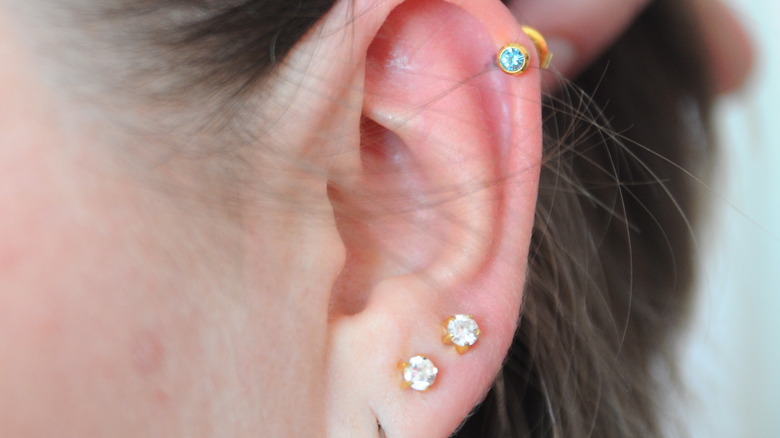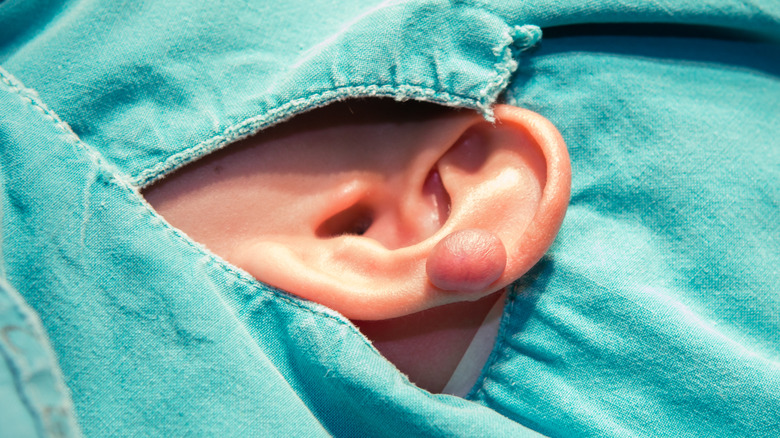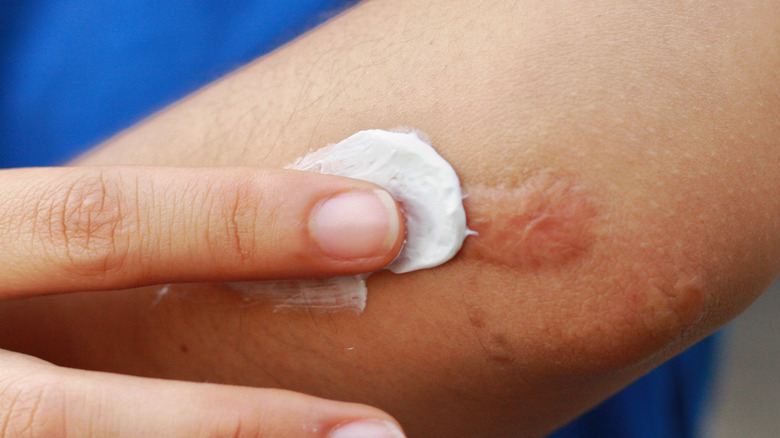Watch Out For This Side Effect With Brand New Piercings
When you get a piercing — and you should definitely think twice before piercing your own ears — aftercare is often the last thing on your mind. Depending on where you decide to get pierced, it's the pain you'll most likely be thinking about. But as the healing process starts to unfold, it's important that you keep an eye on how your body reacts. As a piercing is a sudden injury to the skin, your body will attempt to heal the area straight away by sending collagen to where the skin has been punctured (via Almost Famous Body Piercing).
As your piercing heals, you'll likely experience inflammation and soreness due to this process. Sometimes, this can lead to an infection or even rejection of the piercing altogether (via Medical News Today). Infections and rejection can be caused by your immune system or by any products you've used near the piercing that may interfere with the healing process, like hair or skin products (via Healthline).
If you've managed to avoid an infection or rejection, you still need to keep a close eye on how your new piercing is healing. As your body is pumping more collagen to the area, there's a possibility that you may encounter a bump in or around the piercing. Usually, it's nothing to be too worried about; it's just a natural reaction to the healing process (via MindBodyGreen Lifestyle). But it can develop into something more serious if you don't watch it.
You could be dealing with a hypertrophic or keloid scar
While most bumps that occur during the healing process are just inflammation, they can also be the beginnings of a hypertrophic or keloid scar. You can develop these scars on any piercing, but they're most commonly found in areas that are sensitive to being pierced, like the cartilage of the nose and ears (via Healthline).
First presenting as a bump, the difference between hypertrophic and keloid scars lies in their colors and rates of growth. According to Healthline, hypertrophic scars are generally small, firm bumps that can be pink or red in appearance. Keloid scars can also be firm to the touch, but they tend to be larger with a pink, purple, or skin-tone color. According to dermatologist Loretta Ciraldo, the main way to tell which one you're dealing with is how it grows. As Ciraldo told MindBodyGreen Lifestyle, a hypertrophic scar will form under the surface of the skin while a keloid will grow on top of the skin's surface.
Even though a hypertrophic and keloid scar are "caused by excess scar tissue," per Healthline, the issue with a keloid scar is that it can "grow past the wound and into the surrounding skin" and will continue to grow without proper treatment.
There are ways to treat hypertrophic and keloid scars
Once you've determined whether you have a hypertrophic or keloid scar, you can cater treatment accordingly. But before you do that, it's best to consult with your original piercer or a piercing shop. They'll be able to give you advice on how to treat it, as well as determine exactly whether it's a hypertrophic or keloid scar. If it's the latter, they can advise you on whether you need to seek medical attention for further treatment.
For hypertrophic scars, the main usual treatments include salt or saline soaks or even a massage, according to Healthline. You may also be advised to apply pressure to the site to "break down scar tissue," which is usually achieved by applying a bandage or tape to the piercing.
As keloid scars continue to grow, you'll most likely be advised to get steroid injections. As dermatologist Loretta Ciraldo told MindBodyGreen Lifestyle, this treatment is usually done "in a series of injections spaced three to four weeks apart" and will continue until the keloid has reduced in size or gone altogether. If a keloid is particularly large, you can get surgery to remove it. However, if you're prone to keloids, there's a chance it will grow back as you're inflicting another injury on the skin. But as NYU Langone Health notes, the injection treatment can be administered to the site to prevent reformation.


